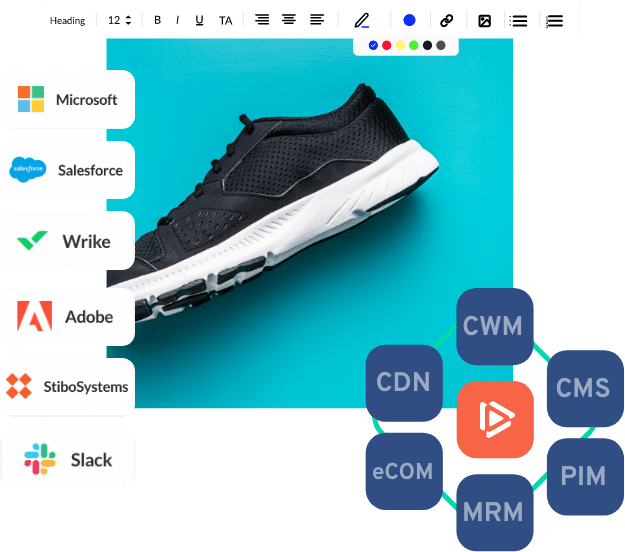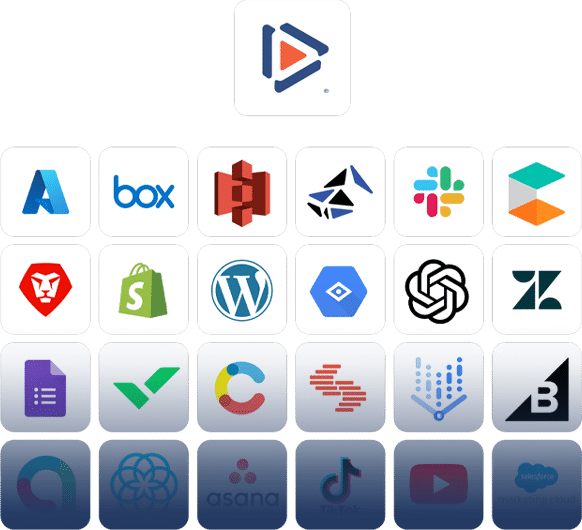
Every article or blog that talks about best practices in digital asset management (DAM) is going to highlight the importance of having a fully integrated enterprise technology ecosystem, within which your DAM will play an important role.
Great. So what does a fully integrated technology ecosystem actually mean? What technologies can you, and should you, integrate with your DAM, and what do those connections actually do? In this blog, we’re going to help answer those questions by listing the most common digital asset management integrations, with a short description of what those technologies will do for you.
If you want to know more about digital asset management integrations, read on!
Why Digital Asset Management Integrations Are Important
Some people might find this to be an obvious answer, but it’s worth mentioning anyway. Integrating technologies to your DAM serves a few purposes.
First, it makes everyone’s lives easier, and that’s important to increasing user adoption of your DAM. The most common reason DAM implementations fail is because users choose not to use the system. This happens for many reasons, one of which being that the DAM just makes their lives harder, not easier.
Integrating the right technologies solves this problem – it can reduce work, time spent on mundane tasks, and errors, letting users find more value out of the DAM and encouraging them to use the tool as it is intended.
Integrations are also important to creating a single source of truth in terms of your data, and your assets. If you can connect your technologies and allow them to share data, you help protect the quality and integrity of that data. The same is true of your assets – sharing them directly to other systems where they’re needed, rather than requiring a user to download and manually move those assets, reduces errors, protects your brand, and saves time.
The last reason we’ll mention here (though there are others) is to increase transparency across the enterprise, reduce data-lag through the organization and make sure all teams have the insights and content they need to execute at the highest levels.
Commonly Connected Enterprise Technologies
Let’s take a look at some of the enterprise technologies that are most commonly connected to digital asset management platforms.
Master Data Management Systems (MDM)
This technology helps companies coordinate their data across the enterprise. Companies have existing data stored in the MDM that needs to be attached to digital assets, so it’s common to have these systems integrated to the DAM. This connection allows the DAM to pull data from the MDM and attach it to the assets.
This is an important integration as it achieves two key things for the company. First, it removes the need for users to manually input data over and over into the DAM when it already exists somewhere else. This reduces the risk of human error corrupting the data, and keeps users productive on valuable tasks, not tedious data-entry.
Second, this integration protects your data. By leveraging the MDM as your source of truth, it allows you to manage that data centrally and trust that it will update the DAM, and other connected technologies, automatically.
Product Information Management (PIM)
Similar to the MDM, the PIM system manages all the data you need to put a product to market – things like SKU numbers, product specifications, tags, etc. Connecting your PIM to your DAM is one of the more common integrations you see, because it supercharges your ability to put products to market effectively.
This connection will allow you to match assets to a SKU in the PIM, and all that product’s vital information will be attached to that asset directly. Some DAMs, like Tenovos, will also share the asset back to the PIM so you can see the content within that system, too.
It also makes the assets in the DAM searchable by the data that is managed within the PIM, like SKU numbers or product specs. More than a quality of life upgrade, this connection will automate metadata for your content that is essential in use cases like ecommerce.
Project Management, Campaign Management & Workflow
These platforms, and others like them, are used by companies to manage different projects, tasks, marketing campaigns, content creation processes, and the list goes on. So, what happens when you connect these systems to a DAM?
First, the integration will create a direct link between the management or workflow software and the DAM library, providing searchable access to all the content in the DAM. This is a crucial connection for creative teams, for example, as they can attach brand assets directly from the DAM to the task in their workflow or project management system, work on those content updates, and feed the updated asset back into the DAM to be used in an upcoming campaign.
The integration will also feed data from the project into the DAM as metadata, which could include things like campaign names, product descriptions, task descriptions, comments – all important contextual metadata that ensures the proper use of the completed asset.
Digital Rights Management (DRM)
Licensing of content is a huge business, just ask our friends at Charles M. Schultz Creative Associates, owners of the Peanuts brand (Charlie Brown, Snoopy and the gang). So, how do you make sure that you’re either controlling access to your content based on license agreements, or that you’re only using the content you have purchased licenses for?
Well, if you do a lot of licensing you may manage those agreements within a digital rights management, or a licensing, system. This is a technology that helps you keep track of who you have purchased from/sold rights to, what the details of those agreements are, when they expire, and so on. Integrating that system with your DAM lets you automatically leverage those agreements to control access to content within your digital asset management platform.
Based on your license agreements, you can automate access of licensees (external parties) to the content they’ve purchased rights to, and pull that access when the agreement expires. Alternatively, you can automatically attach agreement details, such as approved use cases and regions, to the assets you’ve purchased rights to so that your DAM will only give you access to content you’re allowed to use based on those license agreements.
This is an important integration to protect your assets from unauthorized users, and to protect your own company from risk of misusing licensed content.
Creative Suites
Creative teams use specific tools to create and edit assets. Rather than asking these teams to manually download assets, work on them, and re-upload them to the DAM, these connections allow creatives to access their design tools directly from within the digital asset management platform.
These connections allow a reviewer to place comments on the asset and trigger a workflow that notifies the creative, who never has to leave the DAM in order to make the required changes. Not only is this a huge time saver for these teams, but it also helps improve version control of assets, and makes sure only approved assets are used in the creative process.
Business Intelligence (BI)
One of the main benefits of an integrated enterprise tech ecosystem is to provide transparency through data across the organization. Business intelligence tools let you build customized dashboards and perform analysis on data from across the enterprise using multiple data sources.
To put it simply, connecting a BI tool with your DAM lets you pull in asset-level data into those dashboards to include in your analysis. More advanced DAMs will also leverage data back from the BI tool to improve content analysis within the platform, as well.
Building an Integrated Tech Ecosystem
As a member of the MACH Alliance, Tenovos is committed to maintaining an open API architecture that facilitates the quick connection of our enterprise DAM to other technologies in the tech ecosystem.
This allows companies to leverage best-in-breed technologies to power their enterprise, while benefiting from the transparency and synergies these systems can provide.
In order to achieve this integrated vision for your organization, it’s important to speak with your DAM vendors early in your relationship to understand their ability to connect to different technologies. Involve your IT teams, and always ask for examples of how other companies have used similar integrations to power their DAM programs.
If you’re evaluating vendors currently, read our guide on how to choose the right DAM vendor for your organization, which includes details on integration capabilities.
Discover the Fast Track to DAM Integrations
Tenovos Connect offers near-endless DAM integration possibilities with low/no code, enabling brands to connect the technologies of their choice in just a few clicks.

